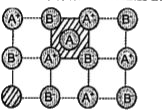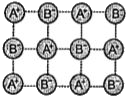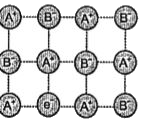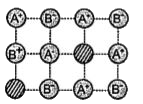Defects which do not disturb the stoichiometry are called stochiometric defect. At the time of crystal formation an ion may not occupy its expected position leaving a void or hole at that site. As a metter of fact one positive and one negative ion are missing from their respective positions leaving behind a pair of holes. This vacancy is a Schottky defect. Due to this defect density decreases. Defect arises in which certain atoms or ions have migrated to interstitial position some distance removed from the holes which they vacated. In this case there is no change in the density of the crystal.
Frenkel defect is generally observed in
AgBr
Agl
ZnS
All of these
The correct Answer is:D
To solve the question regarding the Frenkel defect in ionic compounds, we will follow these steps:
Step 1: Understand the Concept of Frenkel Defect
Frenkel defect occurs when an ion (cation or anion) of smaller size moves from its original lattice position to an interstitial site, creating a vacancy at its original position. This defect does not change the overall stoichiometry of the compound and the density of the crystal remains the same.
Hint: Remember that Frenkel defects involve the movement of smaller ions to interstitial sites.
Step 2: Identify the Conditions for Frenkel Defect
Frenkel defects are typically observed in ionic compounds where there is a significant difference in size between the cation and anion. The smaller ion is more likely to occupy an interstitial site.
Hint: Focus on the size relationship between cations and anions to determine if a Frenkel defect can occur.
Step 3: Analyze the Given Ionic Compounds
The question provides several ionic compounds and asks which of these exhibit Frenkel defects. We need to consider the size of the ions in each compound.
Hint: Compare the sizes of cations and anions in each compound to identify those that have a significant size difference.
Step 4: Conclude on the Answer
Based on the analysis, if all the provided compounds have a significant size difference between their cations and anions, they will all exhibit Frenkel defects.
Hint: If you find that all compounds meet the criteria for Frenkel defects, then the answer will be that all of them show this defect.
Final Answer
The answer is "All of these" (option D), as all the mentioned ionic compounds can exhibit Frenkel defects due to the significant size difference between their cations and anions.
Frenkel defect occurs when an ion (cation or anion) of smaller size moves from its original lattice position to an interstitial site, creating a vacancy at its original position. This defect does not change the overall stoichiometry of the compound and the density of the crystal remains the same.
Frenkel defects are typically observed in ionic compounds where there is a significant difference in size between the cation and anion. The smaller ion is more likely to occupy an interstitial site.
The question provides several ionic compounds and asks which of these exhibit Frenkel defects. We need to consider the size of the ions in each compound.
Based on the analysis, if all the provided compounds have a significant size difference between their cations and anions, they will all exhibit Frenkel defects.
The answer is "All of these" (option D), as all the mentioned ionic compounds can exhibit Frenkel defects due to the significant size difference between their cations and anions.
Similar Questions
Defects which do not disturb the stoichiometry are called stochiometric defect. At the time of crystal formation an ion may not occupy its expected position leaving a void or hole at that site. As a metter of fact one positive and one negative ion are missing from their respective positions leaving behind a pair of holes. This vacancy is a Schottky defect. Due to this defect density decreases. Defect arises in which certain atoms or ions have migrated to interstitial position some distance removed from the holes which they vacated. In this case there is no change in the density of the crystal.
In the Schottky defect
View SolutionDefects which do not disturb the stoichiometry are called stochiometric defect. At the time of crystal formation an ion may not occupy its expected position leaving a void or hole at that site. As a metter of fact one positive and one negative ion are missing from their respective positions leaving behind a pair of holes. This vacancy is a Schottky defect. Due to this defect density decreases. Defect arises in which certain atoms or ions have migrated to interstitial position some distance removed from the holes which they vacated. In this case there is no change in the density of the crystal.
Mark the false statement :
View Solution
Knowledge Check
The crystal showing Frenkel defect is:
A B
B C
C D
D
In the Schottky defect:
Aan ion moves to interstitial position between the lattice pointsBelectrons are trapped in a lattice siteCsome lattice sites are vacantDsome extra cations are present in interstitial spaces
Defects which do not disturb the stoichiometry are called stochiometric defect. At the time of crystal formation an ion may not occupy its expected position leaving a void or hole at that site. As a metter of fact one positive and one negative ion are missing from their respective positions leaving behind a pair of holes. This vacancy is a Schottky defect. Due to this defect density decreases. Defect arises in which certain atoms or ions have migrated to interstitial position some distance removed from the holes which they vacated. In this case there is no change in the density of the crystal.
In stoichiometric defects, the ratio of positive and negative ions as indicated by chemical formula of the compound
View SolutionSchottky defect is-
View SolutionSchottky defect is generally observed in :
View SolutionWhat is Schottky defect in a solid ?
View SolutionExplain on brief Schottky defect.
View SolutionWhich defect causes decreases in the density of crystal?
View Solution